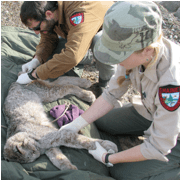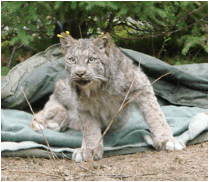Home → Hunting & Trapping → Trapping → Laws & Rules → Reporting the Accidental Catch of Lynx in Traps
Reporting the Accidental Catch of Lynx in Traps
Although Maine's trapping regulations have been modified to reduce the chance that a lynx will be caught in a trap, accidental catches still occur.
Trapper's that are setting traps during Maine's regulated trapping season for upland furbearers are required to report accidental catches of lynx to IFW.
Call 207-592-4734 Phone monitored: 24 hrs a day and 7 days a week during the trapping season.


Captured lynx must be reported to a game warden or biologist of the Department as soon as possible and prior to removing the animal from the trap, unless a Department official cannot be reached in time to prevent injury to the lynx. Any lynx released under this provision must be reported to the Department within 24 hours from the time it was discovered.
- IFW staff are available to help you release the animal
- IFW staff can help you assess the animal for injury
- You can also contact your local MDIFW office or State Police Barracks to report a lynx capture
IFW Response to Lynx In Traps
When a lynx is caught, IFW Wildlife Biologists and Game Wardens work closely to:
- Enforce Maine trapping regulations
- Investigate all accidental catches of lynx in traps
- Assist trappers with the release of lynx from traps
- Assess lynx for injuries based on written criteria developed with a veterinarian
- Determine when a lynx needs veterinarian care and seek treatment
- Document take of lynx and provide report to US Fish and Wildlife Service
When a lynx is caught, IFW Wildlife Biologists and Game Wardens document how the animal was captured, assess the lynx for any injuries that it may have incurred, assist with releasing the lynx, and check compliance with state trapping regulations.
Lynx Protection and Trap Restrictions
View the Lynx Protection and Trap Requirements section of the Trapping Law book for specific trap requirements to help Maine trappers avoid accidentally taking lynx.
Trappers are also encouraged to review this Maine Exclusion Device Check List (PDF) to ensure the exclusion device they are buying or are building is legal in Maine.
Reporting Requirements:
Trappers are required to report the capture of lynx to a Game Warden or Department biologist as soon as possible and prior to removing the animal from the trap, unless a Department official cannot be reached in time to prevent injury to the lynx. Any lynx released under this provision must be reported to the Department within 24 hours from the time it was discovered. Report Lynx Captures to (207) 592-4734 (24 hours a day and 7 days a week).In remote areas, phones are available at NMW checkpoints, custom gates, sporting camps, and logging operations.
Bait Regulations:
- During the early canid and muskrat trapping season, it is illegal to set a trap using exposed bait or visual attractor.
- During the regular trapping season, traps cannot be set with 50 yards of bait that is visible from above.